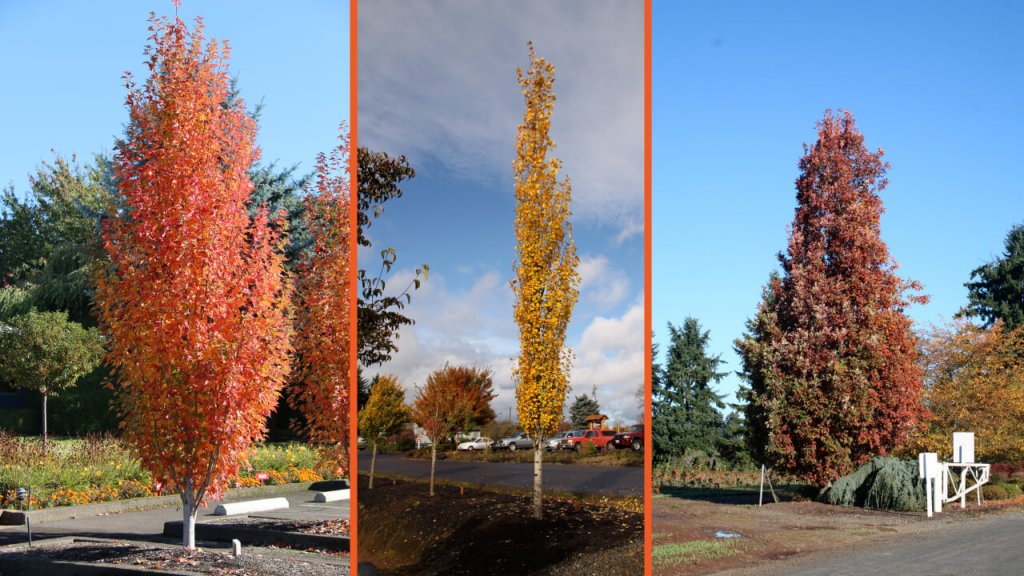Have you ever considered adding skinny trees to your small garden or tight outdoor space? Tall, skinny trees could be the answer.
These trees are ideal for small areas. They grow upwards, not outwards, so they don’t occupy much room. Picture your garden, however small, reaching up to the sky with beautiful greenery.
Imagine a narrow corner beside your house, now alive with the Western Red Cedar or an Italian Cypress.
Each tree is not just a plant; it’s a piece of nature’s art, adding character to your space.
Whether new to gardening or an experienced gardener, these trees are easy to manage.
Let’s explore how these beauties can transform your outdoor area into lush gardens.
1. Western Red Cedar: The Aromatic Natural Pillar

This tree grows in the coastal region of mainland British Columbia and the islands.
The Western Red Cedar is known for its reddish-brown to grey bark and branches that droop and curve upwards at the ends.
These trees thrive in moist soil and shady forests.
Facts
- It has scale-like leaves paired opposite to each other at 90 degrees. Leaves are strongly aromatic and, when crushed, smell like pineapple.
- The seed cones of this tree are shaped like eggs and 1 cm long.
- The bark of this tree is grey and fibrous. There is a noticeable tear-off in the long stripes of the mature trees.
- The average life span of western redcedar is somewhere around 1500 years.
Why Is It a Perfect Fit for Your Landscape?
Western Redcedar is blessed with evergreen foliage. So, no matter what season is on the run, you will always experience a good lush of green.
Also, the pineapple-like smell will add an aroma to your garden that will help you enlighten your mood.
It is a tree that requires very little maintenance and is a safety net for birds and wildlife.
The old wood can be cut down without damage and used to build things like boxes, baskets, or clothing. It can also be used for construction purposes.
While the Skyrocket Juniper is the narrowest, it is ideal for privacy screens. The Western Red Cedar offers a more aromatic presence with its pineapple-like scent.
It thrives in moist, shady environments, unlike the Colorado Blue Spruce, which prefers colder climates.
Its long lifespan of up to 1500 years surpasses many other columnar trees, making it a timeless addition to your landscape.
2. American Arborvitae: The Versatile Green Sentinel
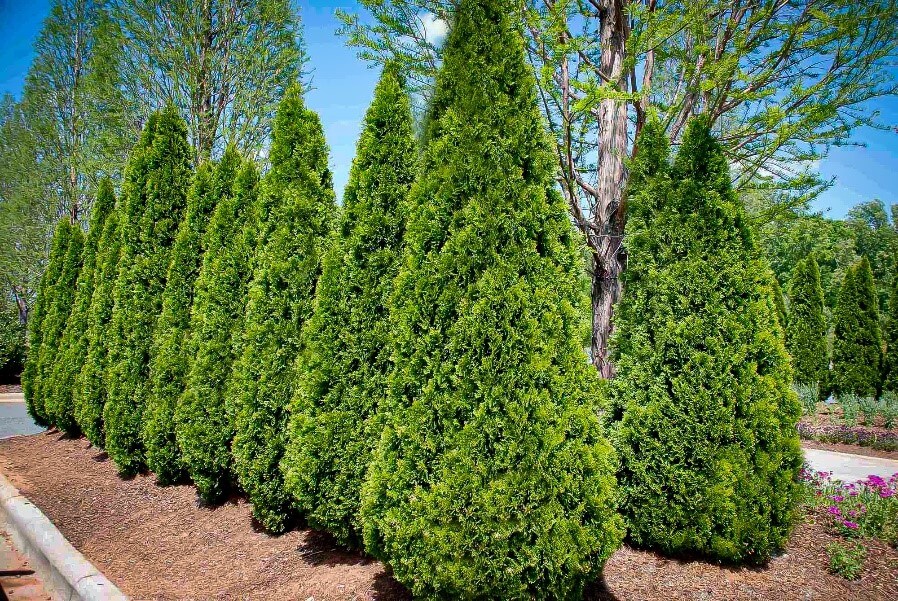
Dark American Arborvitae is conical, featuring flattened sprays of dark green foliage.
It retains a good green color throughout the year, including winter.
Dark American Arborvitae takes pruning well and does best in the sun but should be protected from drying winds.
It makes a great evergreen hedge or can stand alone as an accent evergreen in any landscape.
It will tolerate clay soils and prefers moist but well-drained soil. It can tolerate standing water for a short time.
Dark American Arborvitae will tolerate some shade but not full shade.
Facts
- It has tiny scale-like leaves that are assembled in an overlapping manner to represent a flattened fan-lookalike spray.
- From staying light green in summer to changing hues of yellow-brown-green in the winter, it gives a rich multitude effect.
- The seed cones are oblong-shaped and are around 0.5 cm. The cones are tipped bluntly and prefer to stay separate at the base.
- The barks are in the tones of red and brown. It has narrow, longitudinal stripes.
- The average life span of American arborvitae is observed to be around 50 to 150 years.
Why Is It a Perfect Fit for Your Landscape?
From an architectural point of view, the tree gives an entrance a royal touch.
Putting it in the corner will give your home a soft look. The color-changing foliage gives you a different comfort each season.
The leaves are mildly aromatic, giving you a forest-like feel. It is a low-maintenance tree, except that it requires direct sunlight for at least 6 hours a day.
It offers birds and squirrels food and is known to be used for medicinal purposes, crafts, and construction.
It also provides essential oils for cleansers, insecticides, room sprays, and soft soaps.
This contrasts with the Italian Cypress, which requires very little water and withstands severe heat.
The American Arborvitae is more versatile, adapting well to different soil types, including clay.
Its foliage changes color throughout the seasons, offering a richer visual appeal than the constant green of the Italian Cypress.
3. Weeping Persimmon: Nature’s Teardrop Treasure

The rare Japanese persimmon, the weeping permission, is known for its weeping form.
It offers medium-sized, conical-shaped fruit that hangs off the tree like teardrops.
It is seen to ripen in late October till mid-November.
Facts
- The leaves will take you on a journey of seasons from dark green in spring to blooming flowers by the end of it. The shades that you will witness are – red, fresh yellows, and acute oranges.
- A persimmon can offer you an orange fruit, a sweet treat for you.
- Depending on the season, the color of the bark changes from dark brown to dark gray.
- The average life span that a weeping persimmon is around 70 years to 75 years.
Why Is It a Perfect Fit for Your Landscape?
Persimmon is a one-of-a-kind shaped tree. The majestic look it offers can uplift the landscape of your garden in several ways.
It’s time for you to make your neighbors jealous with a unique gift from nature.
We call it organic jealousy – It’s harmless. You can give your taste buds a treat to the sweet fruits. It is no ordinary tree, is it?
This tree stands out for its ornamental fruit, setting it apart from non-fruiting trees like the Dwarf Alberta Spruce.
Unlike the Swedish Columnar Aspen, susceptible to Bronze leaf disease, the Weeping Persimmon offers a sturdier option with fewer disease concerns.
4. Slender Hinoki Cypress: The Elegant Japanese Sculpture
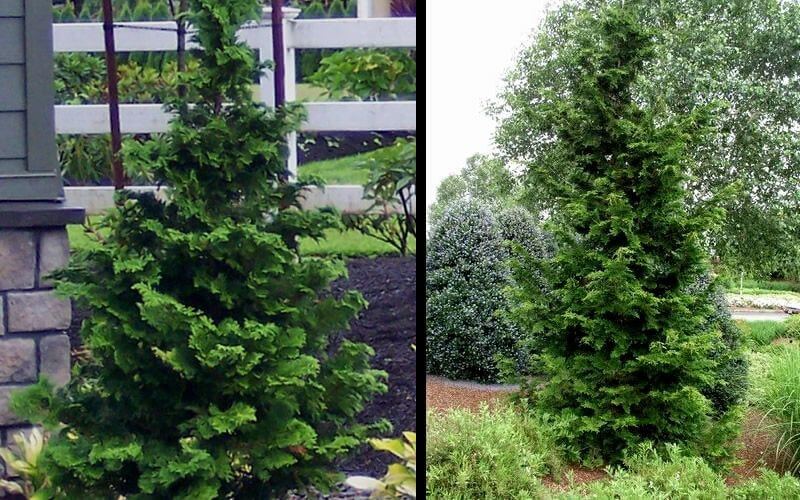
The medium-sized evergreen bush with branches to the ground and narrow habit.
The Slender Hinoki Cypress forms a slender column of soft foliage, a rich green color that becomes red in cold weather.
It is ideal for foundation planting and doesn’t need any trimming. If allowed to grow naturally, it is highly attractive.
Facts
- The ferns of a Hinoki Cypress are dark green, and a little reddishness on the ends will be noticed with regular growth. In winter, a shade of bronze can be enjoyed.
- The seed cones are short, stiff, and spherical in size.
- It has open pyramidical branches that give a soft look to arching branchlets.
- Early spring is the best time to sow seeds to get beautiful hinoki cypress.
Why Is It a Perfect Fit for Your Landscape?
Hinoki Cypress is a delicacy from southern Japan that will add an authentic touch to your landscape.
Also, due to its denseness, it can be used as a privacy screen.
If you are someone with a big garden and love to host barbeque parties, then Hinoki cypress is one of the best choices for its ornamental and bonsai-like look.
Compared to the Lombardy Poplar, known for its rapid growth but disease susceptibility.
The Slender Hinoki Cypress offers a more robust and disease-resistant choice.
Its bronze winter coloration and soft foliage provide a more ornamental appeal than the Flagpole Cherry Tree, primarily valued for its spring blossoms.
5. Italian Cypress: The Towering Tuscan Icon
Italian Cypress tree is perfect for style, elegance, and height. It is a tall, narrow tree that grows up to 50 feet tall.
The tall tree does add beauty to a space and is one of the most popular columnar trees. The trees need very little water and can withstand severe heat.
Facts
- The leaves of this tree are scaled to grow in round shoots, unlike the other trees where the leaves are flattened.
- The seed cones are oblong. The color of seeds is initially green, but once the pollination happens and the tree is matured, it turns into brown.
- The average life span that you can expect from an Italian cypress is somewhere around 1000 years.
Why Is It a Perfect Fit for Your Landscape?
The Italian cypress is a one-of-a-kind tree that brings a touch of Mughal and European culture to your orchard.
The wood is highly scented, bringing fresh, aromatic air to you.
With its tall, narrow growth and European flair, the Italian Cypress starkly contrasts the Colorado Blue Spruce, which has a more rugged, cold-climate look.
Its low water requirement makes it a better choice for arid regions than the Dwarf Alberta Spruce, which prefers more moisture.
6. Walter’s Columnar Red Maple: The Autumnal Showstopper

Known for its columnar form, the Columnar Red maple features clusters of red flowers. In spring, the tree blossoms into a dark green deciduous foliage.
The silver bark and brick-red branches offer the landscapes a unique dimension.
Facts
- Maple leaves need no introduction. It has its unique shape and cutting that is very popular among nature enthusiasts or a layman.
- The cone seeds of this tree come in shades of red and are generally round.
- The branches of red maple trees are initially empty but turn into thin, long branches once matured.
- An average life span that can be expected from a red maple is 60 years to 90 years.
Why Is It a Perfect Fit for Your Landscape?
One thing that makes this a special deal is its deep red-coloured foliage in autumn. It adds color and boldness to your landscape.
The shredded leaves will inspire you to take a walk around and feel nature right in your heart.
Regarding suitability or coverage, red maple is very flexible and is one of the most adapted trees in eastern North America.
If you, by any chance, happen to have a pool in your garden, this will just add an unbeatable flavor to your whole experience of luxury.
This tree’s deep red autumn foliage contrasts the yellow-green fall colors of the Swedish Columnar Aspen.
The Red Maple’s adaptability makes it more suited for various environments than the Lombardy Poplar, which often falls prey to canker diseases.
7. Flagpole Cherry Tree: The Springtime Spectacle
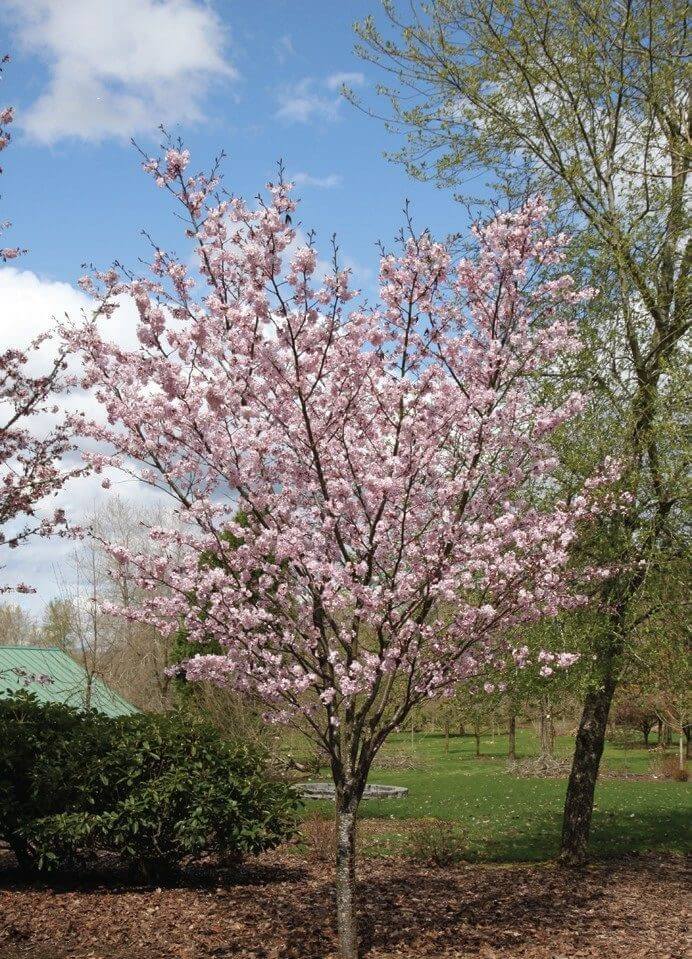
The narrow and columnar Japanese cherry tree, Prunus Amanogawa, is ideal for a garden with limited space.
It is known for its cluster of pink flowers and stunning foliage.
The tree comes to life in autumn when the foliage takes on a diverse range of colors, from burnt orange to deep red and crisp yellow.
Facts
- Get ready to witness the most beautiful spring. Spring is the flowering season, and flagpole cherry trees will fill your yard with aromatic pinkish-white flowers.
- To get the best outcome, make sure it gets ample sunlight.
- In 20 years, you can have a fully matured tree. However, you can enjoy the benefits from the initial years.
- An expected lifespan of a Flagpole cherry tree is 20 to 25 years and if taken a little extra care, it can survive for a longer period.
Why Is It a Perfect Fit for Your Landscape?
If you have a big devoted space for your garden, this cherry tree is your go-to option, and for small spaces.
You can always go for a compact columnar tree that grows up to 6 meters tall.
This cherry tree will not only withstand the toughest of winters, but it also has an added sense of resistance from several pests and diseases.
This tree is one of the most adaptable ones and fits perfectly for the most modern gardens and the most traditional ones.
Its springtime pinkish-white flowers and range of autumn colors provide a visual spectacle unmatched by the more monochromatic Skyrocket Juniper.
The Flagpole Cherry Tree’s resilience in winter compares favorably with the American Arborvitae, which may need protection from harsh winds.
8. Skyrocket Juniper: The Sky-High Blue-Green Marvel
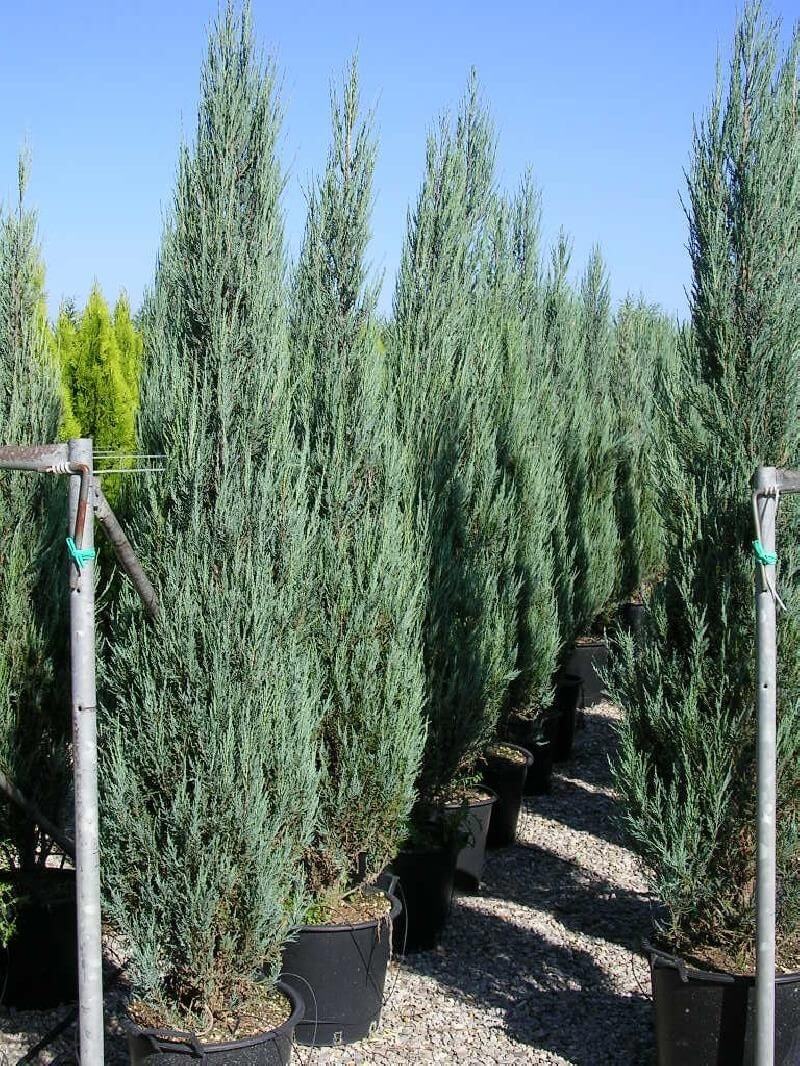
Skyrocket Juniper (Botanical name – Juniperus scopulorum) is a native to North America and grows up to 15 to 20 feet.
It has an impressive ability to create privacy screens because of its narrow and tall skinny structure.
Facts
- The juniper skyrocket is possibly the narrowest juniper. To have a fully matured juniper, you will have to invest 50 years because that’s the amount of time it takes to grow.
- The seed cones are really tiny and round in size. The seed cones are generally mistaken for berries. But that’s okay because birds and squirrels will feast on them anyway.
- Even the bark of Juniper is an attraction to the eyes. It offers an amazing shredding experience and comes in the shade of reddish-brown.
Why Is It a Perfect Fit for Your Landscape?
The Skyrocket Juniper will make a beautiful focal point for your landscape because of its widely known characteristics.
Plus, it has this unique bluish-green foliage, which creates a very subtle and a little fancy outlook for your open yard.
It takes a long time to mature as it is a self-maintained tree and requires minimal pruning. The woods and leaves of juniper have an aromatic characteristic as well.
This adds a beautiful aroma to your landscape and helps you keep up with your mood.
Its narrow and tall structure makes it an ideal privacy screen, much like the Lombardy Poplar, but with greater disease resistance.
In contrast to the Dwarf Alberta Spruce, the Skyrocket Juniper offers a taller, more prominent vertical element in the landscape.
9. Lombardy Poplar: The Fast-Growing Privacy Shield
:max_bytes(150000):strip_icc()/lombardy-poplar-trees-2132395-hero-b154d452a34544d18e0dd7b7be45cad2.jpg)
Lombardy Poplar (Botanical name – Populus Nigra) is native to southwest and central Asia. It is also known as black poplar and grows to 40 to 60 feet.
The properties widely use these to create windbreaks and avoid blowing off farms by topsoil.
Facts
- Lombardy poplar is deciduous. The leaves are in the shape of diamonds and go from bright green to a beautiful golden yellow as per the seasons.
- The blooming of flowers can be experienced in spring. Please do not confuse it with one of the ornamental trees because it is not one of them.
- When the tree is young, the bark’s color is grey and green. But as time passes, the barks turn out to be black in color, and that is why it is also known as black poplar.
- An expected lifespan of Lombardy poplar is somewhere around 40 to 50 years.
Why Is It a Perfect Fit for Your Landscape?
Lombardy Poplar is a rock star of tall, skinny trees. If planted carefully, it will create a beautiful piece of privacy screen.
They grow up fast but have become extinct due to catching on canker diseases.
This is one of the biggest disadvantages of getting involved with Lombardy Poplar; it attracts a lot of pests and diseases.
Therefore, many of them die in 15 to 20 years. This also puts them in the category of high-maintenance trees.
If you choose Lombardy poplar to be a part of your garden, make sure they are open to full sunlight and a soil type that has good drainage.
This tree’s rapid growth makes it an excellent choice for creating quick privacy screens, outpacing the slower growth of the Swedish Columnar Aspen.
However, its susceptibility to diseases makes it a higher-maintenance option than the robust and long-lived Colorado Blue Spruce.
10. Colorado Blue Spruce: The Frosty Blue Sentinel
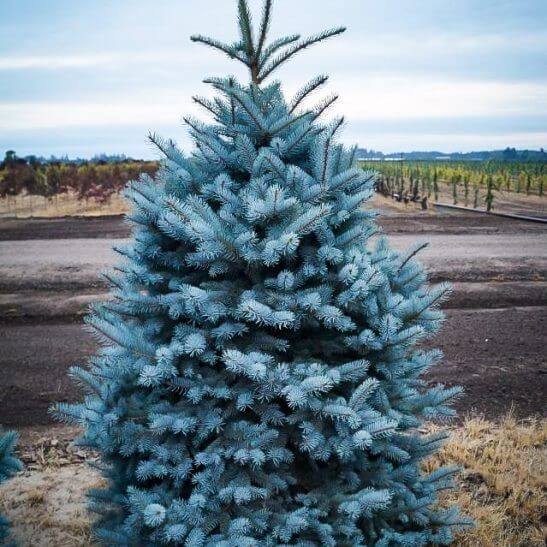
Colorado blue spruce (Botanical name – Picea Pungens) is a native to North America and grows up to 45 to 50 feet.
This is one of the best-suited columnar for regions that tend to stay cold most of the time.
Facts to Know
- The leaves are crossed sections on quartered angles and are rigid. The foliage is silver, but the color of the leaves is bluish-green in the shade. Hence, this is a perfect fit for a fancy-subtle category.
- Seed cones are generally found on the upper crown and are pale green initially. After ripening, it turns into a red color.
- The bark of this columnar is greyish-brown in shade. Branches grow from slight to strong droops and are usually yellow-brown.
- The expected lifespan of a Colorado blue spruce is somewhere around 600 to 800 years.
Why Is It a Perfect Fit for Your Landscape?
If your home is in someplace like Sweden, where the sun is a rare miracle, Colorado blue spruce is a perfect choice.
It can easily tolerate temperatures of up to -40 degrees Celsius. It keeps growing the whole year and gives a beautiful shade of silver and blue.
This is one of the low-maintenance trees and is often mistaken for a Christmas tree.
So, if you forget to buy a Christmas tree next time, you can always light up this beautiful blue spruce.
Preferred for colder climates, it contrasts with the Italian Cypress that thrives in heat.
The Blue Spruce’s blue-green foliage provides a unique color palette compared to the traditional green of the American Arborvitae.
11. Swedish Columnar Aspen: The Golden Fall Beacon
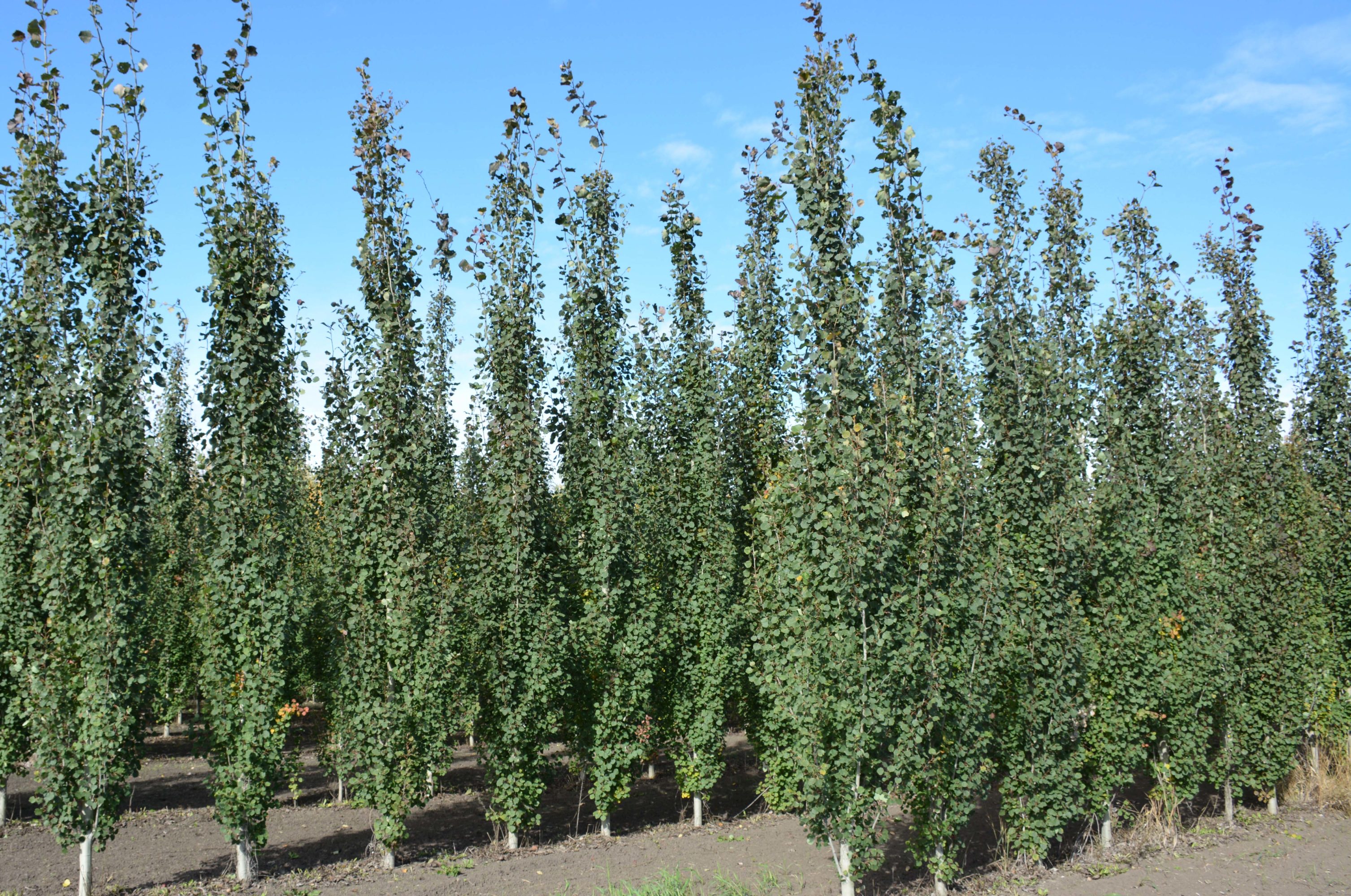
Swedish Columnar Aspen (Botanical name – Populus Tremula ‘Erecta’) is a pole-like stunning tall skin tree that grows up to 25 to 30 feet.
This tree is really popular when you are planning for a mass plantation.
In case of mass plantation, the distance between the trees has to be calculated very professionally so there is enough room for the roots to grow.
Facts
- The foliage is blessed with a beautiful shade of emerald green that turns into golden yellow during the fall season.
- The barks are striped with shades of grey and brown. The bark also contains an element of lenticel that serves as open pores for gas exchange.
- The average lifespan of Swedish columnar aspen is somewhere around 30 to 50 years.
Why Is It a Perfect Fit for Your Landscape?
To get a perfectly brown Swedish columnar aspen, make sure that it gets direct sunlight.
The most suited soil type for aspens is well-drained and deeply moisturized.
The aspens are deciduous and therefore provides a heavily shaded site to your open yard or orchard. However, the plantation of Swedish aspens increases the spread of Bronze leaf disease.
Its golden yellow fall foliage starkly contrasts the red and orange hues of the Weeping Persimmon. Unlike the more disease-prone Lombardy Poplar, the Aspen provides a hardier landscape option.
12. Dwarf Alberta Spruce: The Petite Evergreen Charm
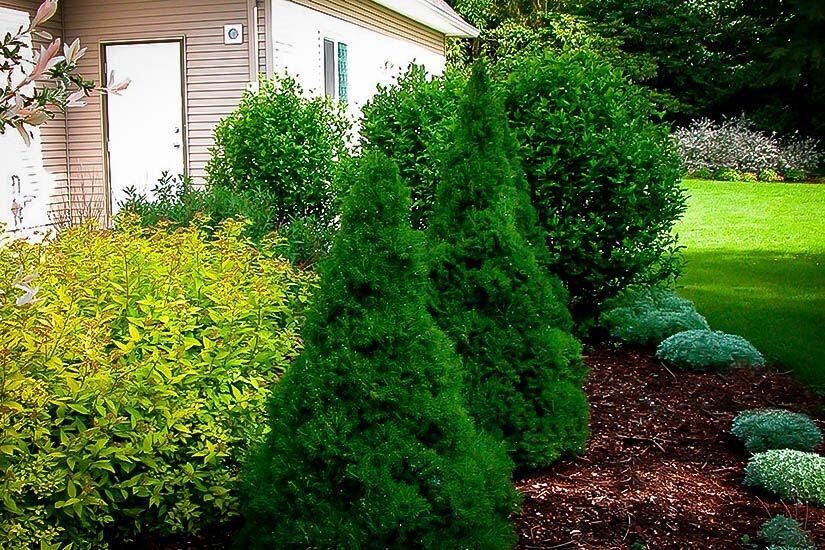
Dwarf Alberta Spruce (Botanical name – Picea Glauca ‘Conica’) is native to North America and grows up to 10 to 13 feet.
If you desire a columnar tree but don’t want a tall skinny tree, then Dwarf Alberta spruce is a lifesaver.
Facts
- The foliage is lush green, and due to the heavy density in growth, it gives an authentic green shade of nature.
- The barks are greyish-brown, structured in a scaly manner, and very thin.
- Being a non-flowering plant, it produces no flowers or seed cones.
Why Is It a Perfect Fit for Your Landscape?
Whether a cold winter or a cool summer, dwarf spruce is designed to sustain in both. It gives a lush green look to your space.
You can also grow them in containers and keep them in your windows or right outside your door in the corner.
The dwarf spruce is a sunlight baby that means it requires direct sunlight and a soil type that is neutral in pH level.
It is categorized under the low-maintenance tree. So, the good news is that you can prune it at your own sweet time.
It is ideal for small spaces where trees like the towering Italian Cypress would be impractical.
Its dense, green foliage provides year-round color, unlike Walter’s Columnar Red Maple, which is deciduous.
Final Thoughts
So, thinking about tall skinny trees for your garden? Great choice! They’re like natural skyscrapers but for plants.
They don’t need much room and can jazz up a small space. Imagine having a tree like the Western Red Cedar – it smells amazing and looks gorgeous.
Or the Italian Cypress, super tall and stylish. Even the Weeping Persimmon is pretty unique with its teardrop fruits.
It’s all about picking the right tree for your garden’s vibe. These trees can turn a simple yard into something special.
It’s like giving your garden a mini makeover with just one tree. So, go for it; let these trees reach for the sky and make your garden stand out.
Remember, it’s not just about the space on the ground; it’s about how you use it up in the air, too!

